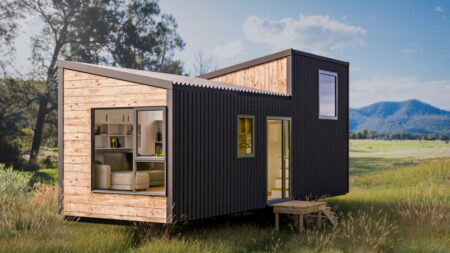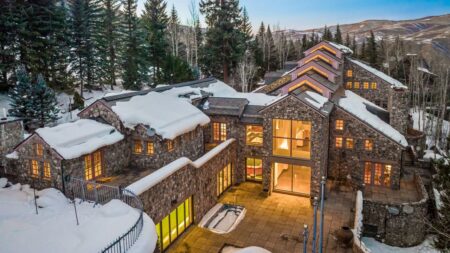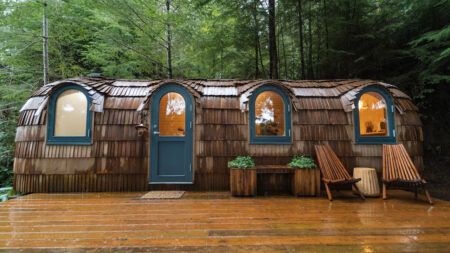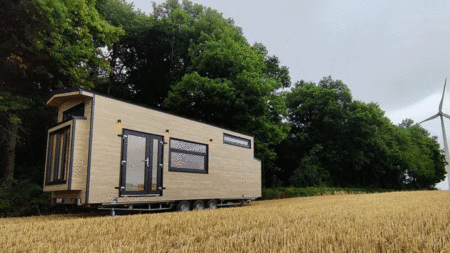Looking for a 100% natural building material? Cob is the answer. It is one of the most eco-friendly construction materials which is incredibly strong and durable. Cob a mix of sandy-sub soil, clay, straw and a bit of angular stones/gravel. Each material used lends its unique property to the cob house.
Why a cob house
Since a cob house is constructed from the on-site material, it is one of the most sustainable forms of building. Compared to other building techniques, making a cob house is much easier, with no need for previous building experience. There is greater flexibility in how to design a cob house, as the building material (cob) is easy to work with, making it a free-form sculptural method of construction.
Advantages of a cob house
- They are breathable and have no dampness inside
- Carbon footprint of a cob house is almost nil compared to concrete buildings
- Demolishing a cob house has minimal impact on the environment
- Aesthetically beautiful as they merge well with the surrounding landscape
- Affordable due to the low cost of material and construction
- Energy-efficient due to natural temperature regulation inside
- Built from locally sourced natural building materials
- Creativity and flexibility in building due to moldable qualities
- Extremely durable and solid due to the use of straw in cob mix
- Termite proof, fireproof and earthquake-proof
- Free from toxic emissions, thereby maintaining the oxygen-nitrogen levels of the soil underneath
- Acoustically optimized due to sound-absorbing properties
Also Read: Ten Best Cob Houses And The Benefits Of Building One
How long does it last
Cob was commonly used as a material for erecting homes in England in the 19th century, and some of those structures still stand tall. In fact, the oldest cob house was built 10,000 years ago during the Pre-Pottery Neolithic period in the Judean lowlands southwest of Jerusalem.
Get the cob mixture right, lay a good foundation, foolproof the roofing and apply a protective plaster, and strength of the cob house can be assured for years to come.
How to build a cob house
Building a cob house is easy when compared to other building techniques as it requires very basic construction knowledge. A bit of study about the right mixture of clay, sand and stray (depending on the temperature regulation requirements), a mud house can be erected.
A checklist to follow:
- Check with your local municipality about the possibility of building a mud house as some areas don’t allow construction of non-traditional structures.
- Choose a flat spot for constructing your cob house as it would be less labor-intensive.
- Come up with a construction plan for the structure.
- Create a solid foundation using cob or cement.
- Use your mud boots to mix the cob mixture for walls.
- Be careful while smoothening the walls so that they come out uniform and vertical.
- Add multiple layers of cob mixture for structural strength and stability.
Where to build
To be on the safer side, cob house should be built in moderate climate areas, as extreme climatic conditions require passive cooling or heating the interiors. That being said, it doesn’t mean a cob house cannot regulate the temperature on its own.
Depending on the content of straw bale/wattle-and-daub, a cob house can provide heat insulation or passive cooling.
However, a cob house is not advised for places with high flooding or natural disasters like hurricanes or tornado.
Things to keep in mind while building one
Although the disadvantages of building a cob house are few when compared to advantages, still they need to be considered. Always remember:
- Lack of proper ventilation can make a cob house humid on the inside
- Lack of uniform design may lead to problems with interior decoration
- It is quite a labor-intensive task to build a cob house
- Cob house can take quite a long time to build as each layer takes time to dry
- Extremely hot or cold regions might require temperature regulating equipment
- In some areas building a cob house may require special permits
Cob house cost
A decent cob house can be built for anything ranging around $4,000 – $10,000. However the cost can vary depending on the climatic condition, location and the size of the house. The basic cost, however, may lie somewhere around $2000 – $5000.
The final cost may be much higher if you want swanky interiors with unique designs and sculptural walls. If you compare the building cost to modern construction methods, it is far less on any given day, as long as you are ready to get your boots dirty.
Building a mud house is very much in trend these days due to its environment-friendly nature. If you have a spare piece of flat land and enthusiasm for building a sustainable home, here is your chance.
It will be a very fruitful and satisfying experience on the whole; not to mention all the attention the house will garner.
Follow Homecrux on Google News!





Just love these cob houses.
Where can I find a builder in Western Australia?